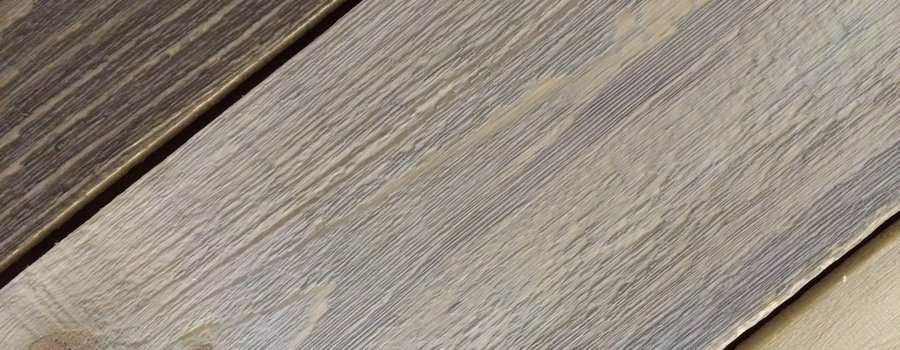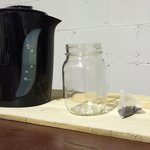We already discussed this sad reality in a previous post: Reclaimed Barn Wood is extremely popular these days, and getting your hands on a sufficient quantity for a project can be rather expensive: Lower production combined with an explosion of demand in these pandemic times have caused wood prices to skyrocket. Although the unique patina of wood that has been ageing outside while being exposed to the elements is quite difficult to perfectly reproduce, there are a few relatively simple methods that can allow you to artificially weather new wood. Here's how to do it.
A homemade stain to weather wood
In order to obtain a weathered wood effect, you can prepare an oxidizing solution that will act as a stain. To do so, all you need is one litre of white vinegar and a pad of fine steel wool: Put the medium or fine steel wool in a Mason Jar or a similar glass content. Try to rip the steel wool in several pieces so it'll dissolve faster in the vinegar solution. When you're done, close the jar and let the vinegar dissolve the steel. You can shake the jar from time to time to accelerate the process, which should take between 3 and 7 days. As simple as that!
Once the steel wool is completely dissolved, the stain is ready, but it is too concentrated: It is recommended to dilute it with 50% water, which will yield 2 liters of stain. With practice, you might want to vary the concentration depending on the desired effect. But before you go any further, it might be a good idea to brew a nice tea before beginning the project...
Black tea, please! Strong!
Used alone, the oxidizing solution you just prepared will darken and give a weathered effect to wood essences that are naturally rich in tannins, such as oak, cedar, spruce, etc. However, for woods that have very low tannins, applying a strong, black tea on the wood first will activate the oxidizing solution and provide a much better result. Applying black tea over wood will not change the color of the wood at first. It is when you apply the oxidizing solution over it that the magic operates!
If you don't know which wood essences you're dealing with, it might be safer to run a few tests, since a few of them can blacken almost completely should you use a black tea + Oxidizing solution combination. In this case, skip the tea part completely and directly apply the oxidizing solution.
Once the tea has been applied or if your wood has a high tannins content, it's time to apply the oxidizing solution. Ideally, it will be applied with a synthetic bristles brush in a well ventilated area. The solution might smell bad, but are not dangerous. You don't have to wait until the tea has dried, you can start right away.
Visual Guide: Black Tea and Oxidizing Solution/Stain
An alternative to Vinegar and Steel Wool: Wood treatments in powder form
An alternative that also yields interesting results is using wood treatments sold in powder form (to be mixed with water) which accelerate the weathering of wood. There are two excellent Canadian products made exactly for this purpose. Let's look at them and offer a comparison.
First, there is LifeTime Wood Treatment. Although it has been originally designed to protect and accelerate the greying/aging process of exterior wood with the help of UV rays and exposure to elements, using black tea allows you to "cheat" with the product and obtain a weathered look on new wood much faster. The result is less intense than the combination of black tea and the oxidizing solution, but it allows to obtain very nice silvery tones, especially on spruce. For those with a lot of patience or who are not in a rush for their project, you could use LifeTime alone and let the sun, rain, and time do their work by putting your LifeTime treated wood outside for 6 to 12 months. The result is a more natural look, almost identical to wood that has been outside for many decades.
A newer, more recent product is Instant Barn Wood. Its main advantage, as the name suggests, is that it acts instantly and that wood treated with this product does not need to be exposed to the elements (sun, rain) to get a nice weathered patina look. Instant Barn Wood also includes a packet of "booster", which allows to treat wood that is usually harder to color, in this case harder woods, which absorb penetrating products less easily. The company has also prepared an illustration which shows what kind of results can be expected on different types of wood by using the product alone or by using the "booster" and two coats of the product. For some hardwoods, such as walnut or maple, the difference ban be quite significant.
Instant Barn Wood is therefore a clear winner if you want wood that looks like barn wood immediately without having to apply black tea first, or for an interior project. In the case of exterior projects, both products should perform similarly and provide excellent results on softwoods. For hardwoods outdoors, Instant Barn Wood, thanks to its booster, will allow you to achieve darker results if that's the desired goal, again, without having to apply a coat of black tea. Note that both products are very easy to use. They can be applied with a synthetic or foam brush, a roller, a sprayer, or by simply soaking the wood in the mixture, depending on preference and the type of surface to be treated.
Visual Guide: Black Tea & LifeTime Wood Treatment, and LifeTime & Instant Barn Wood on outdoors projects
Oh no! My fake barn wood planks have different colors/tones!
It is possible that once dried, your treated wood planks won't have a uniform color and/or tone, especially if you used many different wood types. In general, this is the effect that is sought after, and gives a more authentic rustic/antic charm to a reclaimed barn wood project. If this is the effect you're looking for, then you will benefit from varying wood essences and combining the two methods described above, to have as much varied wood tones and colors as possible.
However, for those of you seeking a more uniform look, you should stick to a single essence of wood and a single method among the two methods we've shown you. You can also do a very light sanding on darker surfaces, which will lighten the color.
Note that the two methods highlighted above can also be really useful on freshly cut real or fake reclaimed barn wood. When barn wood has been cut, the cut ends are much lighter in color since they've never been exposed to the elements and to the sun rays, which are responsible for creating the grey/brown patina. By using either methods, you will be able to attenuate the color differences and have a more uniform look.
There you go! You now have a nice Reclaimed Barn Wood imitation, which should be able to fool even the best connoisseurs! The only thing that you need to do now is to protect your project with an appropriate finish...!



























